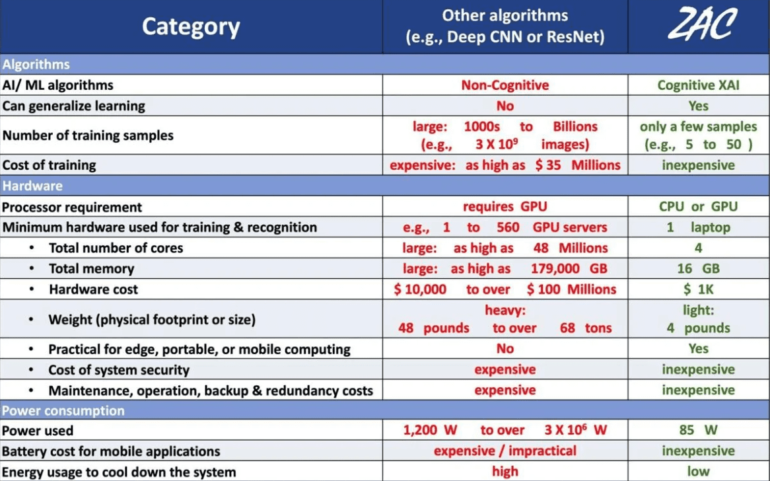TL;DR:
- Z Advanced Computing, Inc. introduces “Describer,” an AI tool for accurate 3D object descriptions.
- US Air Force benefits from ZAC’s breakthrough in AI image recognition.
- “Describer” uses minimal training samples and low computing power, setting it apart from industry norms.
- ZAC’s algorithms excel where others falter, comprehending 3D objects from any viewpoint.
- Dr. Bijan Tadayon highlights the significance of both defense and medical imaging.
- ZAC holds an impressive IP portfolio with 450+ inventions and 13 US patents.
- The development is led by Saied Tadayon, a math prodigy with exemplary credentials.
- Notable advisors include Nobel Laureates, inventors, and industry luminaries.
- ZAC’s achievements redefine 3D object analysis and promise broader innovations.
Main AI News:
In an extraordinary stride forward, Z Advanced Computing, Inc., a pioneering Cognitive Explainable-AI (CXAI) software startup, has unleashed its groundbreaking innovation named the “Describer.” This revolutionary tool harnesses the potential of artificial intelligence to generate accurate, automated descriptions and intricate measurements of intricate 3D objects. The beneficiaries of this remarkable feat? None other than the US Air Force (USAF), where this development represents a significant breakthrough in the realms of AI and Machine Learning (ML).
What distinguishes ZAC’s accomplishment even further is the fact that their “Describer” operates on a mere handful of training samples, wielding significantly fewer computational resources. In a stunning departure from convention, ZAC’s technology soars on the wings of an average laptop, relying solely on CPU power sans the assistance of GPU servers. This achievement stands in stark contrast to prevailing industry algorithms, including statistical models, Neural Nets, Deep CNNs, ResNets, and GANs, which falter in their attempts to fathom the dimensions and descriptions of 3D objects. These incumbents also clamor for vast amounts of training data, often spanning the gamut from thousands to billions of samples, cultivated on sprawling GPU server setups.
Dr. Bijan Tadayon, ZAC’s visionary CEO, underscores the monumental implications of their algorithms, asserting, “ZAC algorithms hold the key to comprehending and quantifying 3D objects from any vantage point, thereby delivering comprehensive elucidation.” Dr. Bijan Tadayon is unwavering in his assertion that this technological marvel will not only reshape the AI landscape for the US Air Force but will also be harnessed in the realm of Medical Imaging.
ZAC’s distinguished repertoire boasts an extensive IP portfolio, adorned with over 450 innovations, including a collection of 13 US patents that stand testament to their pioneering spirit.
Steering this journey of innovation is none other than Saied Tadayon, the beacon of leadership behind ZAC’s trailblazing development. An erudite scientist, a seasoned software architect, and a mathematical prodigy, Saied’s journey includes a remarkable stint as the top-ranked undergraduate at Cornell University, culminating in the attainment of his PhD from the same institution at the tender age of 23.
ZAC’s ascent to greatness is further fortified by an illustrious cadre of luminaries, lending their wisdom and expertise as advisors. The esteemed roster includes the likes of Prof. David Lee, a Nobel Laureate in Physics; Prof. Mory Gharib, former Vice Provost of Research at Caltech and an indefatigable entrepreneur and inventor; and Prof. Gholam Peyman, MD, the visionary behind LASIK and a recipient of the National Medal of Technology and Innovation bestowed by the US President. The late Prof. Robert Buhrman, former Senior Vice Provost of Research at Cornell, and Prof. Mike Spencer, former Associate Dean of Engineering for Research at Cornell, lend their sagacity to ZAC’s endeavors. Prof. Mo Jamshidi, Founding Director of NASA’s Center for Autonomous Control, and a luminary on the US Army Science Board, contributes his insights to this esteemed assembly. Notably, the late Prof. Lotfi Zadeh of UC Berkeley, an eminent figure credited as the Father of Fuzzy Logic, a co-inventor of the Z-Transform, and an inductee into the AI Hall of Fame, is also celebrated as one of ZAC’s venerable inventors.
Conclusion:
ZAC’s innovative “Describer” technology marks a pivotal advancement in AI-driven 3D object understanding. Its potential to accurately describe and measure objects from multiple angles with minimal resources is poised to transform defense, medical imaging, and beyond. This breakthrough underscores ZAC’s leadership in the AI landscape, sparking anticipation of transformative shifts across industries.

